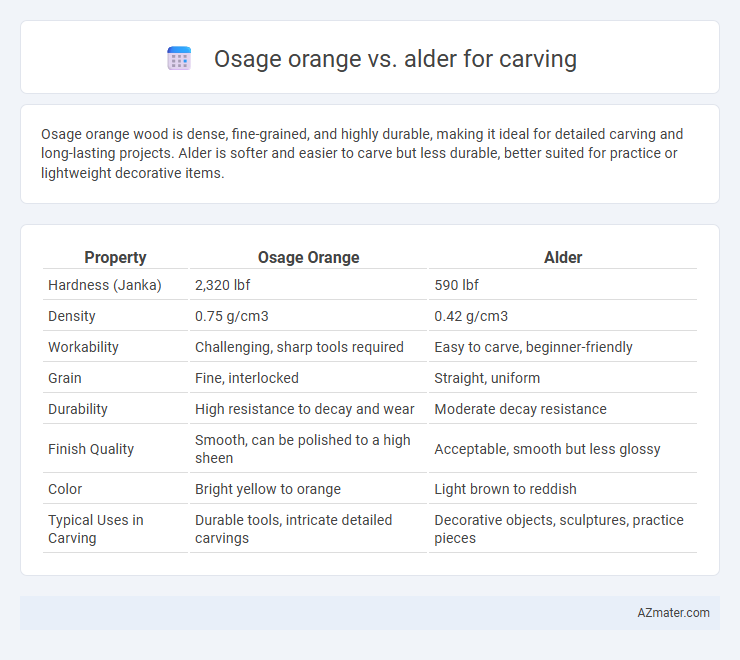Osage orange wood is dense, fine-grained, and highly durable, making it ideal for detailed carving and long-lasting projects. Alder is softer and easier to carve but less durable, better suited for practice or lightweight decorative items.
Table of Comparison
| Property | Osage Orange | Alder |
|---|---|---|
| Hardness (Janka) | 2,320 lbf | 590 lbf |
| Density | 0.75 g/cm3 | 0.42 g/cm3 |
| Workability | Challenging, sharp tools required | Easy to carve, beginner-friendly |
| Grain | Fine, interlocked | Straight, uniform |
| Durability | High resistance to decay and wear | Moderate decay resistance |
| Finish Quality | Smooth, can be polished to a high sheen | Acceptable, smooth but less glossy |
| Color | Bright yellow to orange | Light brown to reddish |
| Typical Uses in Carving | Durable tools, intricate detailed carvings | Decorative objects, sculptures, practice pieces |
Introduction to Osage Orange and Alder Wood
Osage orange wood is prized for its extreme hardness, durability, and distinctive bright yellow heartwood, making it ideal for detailed carving and long-lasting projects. Alder wood, by contrast, is softer, easier to carve, and features a fine, straight grain with a pale brown color that stains well, suitable for beginners and intricate work. Both woods offer unique properties: Osage orange excels in toughness and weather resistance, while alder provides a smoother texture and greater ease of use.
Wood Grain and Texture Comparison
Osage orange wood features a dense, fine, and consistently tight grain with a smooth texture, making it ideal for detailed carving and fine finishes. Alder wood, by contrast, has a softer, straight, and coarser grain with a uniform texture, allowing for easier shaping but less intricate detail retention. The hardness and closed grain of Osage orange provide superior durability, while alder's softness offers versatility and a smoother carving experience for beginners.
Hardness and Workability Differences
Osage orange wood is significantly harder, with a Janka hardness rating of approximately 2,560 lbf, making it highly durable but more challenging to carve compared to alder, which has a Janka hardness of about 590 lbf. Alder offers superior workability due to its softer texture and fine, straight grain, allowing for easier shaping and detailing in carving projects. The difference in hardness affects tool wear and carving precision, with alder preferred for intricate designs and Osage orange suited for robust, durable carvings.
Carving Detailing and Finish Results
Osage orange offers a dense, fine-grained texture that holds intricate carving details exceptionally well, resulting in clean, sharp lines and a smooth finish ideal for detailed work. Alder wood, while softer and easier to carve, tends to produce less defined detailing and a slightly rougher finish, making it better suited for projects where fine precision is less critical. The hardness and natural oils in Osage orange contribute to a durable and polished final product, whereas Alder requires more sanding and finishing to achieve a comparable smoothness.
Tool Wear and Maintenance Concerns
Osage orange wood is exceptionally dense and abrasive, causing increased tool wear compared to alder, which is softer and easier to carve. Tool maintenance is more demanding with Osage orange due to its hardness, requiring frequent sharpening to maintain cutting efficiency. Conversely, alder's softer fibers reduce blade dulling, allowing for longer usage between sharpening and less overall maintenance.
Availability and Sustainability
Osage orange is a dense, durable hardwood often favored for carving due to its fine grain and resistance to wear, but it is less commonly available and primarily found in North America. Alder, widely accessible and sustainably harvested, offers a softer texture ideal for detailed carving and faster work. Sustainable sourcing practices for alder make it a more environmentally friendly choice compared to Osage orange, which can be limited by geographic availability and slower growth rates.
Cost Analysis for Carvers
Osage orange wood is typically more expensive than alder, with costs ranging from $10 to $15 per board foot compared to alder's $5 to $8 per board foot, making alder a more budget-friendly choice for carvers. Osage orange offers superior hardness and durability, leading to longer-lasting carvings, which can offset its higher initial expense over time. Alder's softer texture allows for easier carving and is ideal for beginners or projects requiring intricate detail without the high material cost.
Natural Color and Aging Effects
Osage orange wood features a vibrant yellow-orange color that deepens to a rich olive-brown with exposure to light and air, enhancing carving detail over time. Alder wood presents a softer, pale reddish-brown hue that darkens slightly to a warm brown, maintaining a consistent and subtle aging profile. Osage orange's dense grain offers excellent durability and color retention, while alder provides ease of carving with moderate color change, catering to different artistic preferences for natural aesthetics.
Common Applications in Wood Carving
Osage orange is prized in wood carving for its dense, fine grain and durability, making it ideal for tool handles, intricate sculptures, and outdoor projects exposed to weather. Alder wood offers a softer, more workable texture favored for detailed relief carving, furniture accents, and decorative pieces requiring smooth finishes. Both woods are favored by carvers, with Osage orange excelling in toughness and alder in ease of shaping and sanding.
Final Recommendations for Carvers
Osage orange offers unparalleled durability and a fine grain ideal for intricate carving, making it a top choice for artisans seeking long-lasting, detailed work. Alder is softer and easier to carve, perfect for beginners or projects requiring smoother, less dense wood. For final recommendations, carvers prioritizing hardness and weather resistance should choose Osage orange, while those seeking ease of shaping and finishing may prefer alder.

Infographic: Osage orange vs Alder for Carving
 azmater.com
azmater.com